Family Therapy Terminology & Definitions – Flashcards
Unlock all answers in this set
Unlock answersquestion
ALIGNMENTS
answer
Clusters of alliances between family members within the overall family group; affiliations and splits from one another, temporary or permanent, occur in pursuit of homeostasis.
question
ANOREXIA NERVOSA
answer
Prolonged, severe diminution of appetite, particularly although not exclusively in adolescent girls, to the point of becoming life-threatening.
question
ACCOMMODATING
answer
A therapeutic tactic, used primarily by structural family therapists, whereby the therapist attempts to make personal adjustments in adapting to the family style in an effort to build a therapeutic alliance with the family
question
ATTACHMENT
answer
The quality of the relationship between infant and principal caregiver that affects a person's sense of self and relationships with others. Attuned attachment between mother and child will likely lead to relatively stable senses of self and others, whereas miss-attuned or traumatized attachments may lead to disturbed senses of self and relationships with others.
question
BASELINE
answer
A stable, reliable performance level, against which changes, particularly of a behavioral nature, can be compared.
question
BEHAVIORAL MODEL
answer
The viewpoint that objective and experimentally verified procedures should be the basis for modifying maladaptive, undesired, or problematic behaviors
question
BEHAVIORAL ANALYSIS
answer
An assessment procedure in which a therapist identifies the targeted behavior to be changed, determines the factors currently maintaining the behavior, and formulates a treatment plan that includes specific criteria for measuring the success of the change effort.
question
BEHAVIORAL COUPLES THERAPY
answer
Training couples in communication skills, the exchange of positive reinforcements, cognitive restructuring, and problem-solving skills in order to facilitate marital satisfaction.
question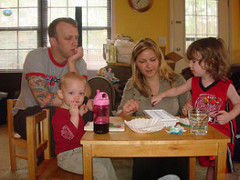
BEHAVIORAL PARENT TRAINING

answer
Training parents in behavioral principles and the use of Contingency management procedures in altering or modifying undesirable behavior in their children.
question
BINUCLEAR FAMILY
answer
A post-divorced family structure in which the former spouses reside in separate households and function as two separate units; their nuclear family is thus restructured but remains intact.
question
BIPOLAR DISORDER
answer
An affective disorder in which the patient experiences alternating periods of depression and mania.
question
BLANK SCREEN

answer
In Psychoanalytic therapy, the passive, neutral, unrevealing behavior of the analyst, onto which the patient may project his or her fantasies.
question
BOUNDARY

answer
An abstract delineation between parts of the system or between systems, typically defined by implicit or explicit rules regarding who may participate in what manner.
question
BOUNDARY MAKING
answer
A technique of structural family therapists aimed at realigning boundaries within a family by changing the psychological proximity( closer or further apart) between family subsystems.
question
CENTRIFUGAL

answer
Tending to move out word or away from the center; within a family, forces that pushed the members apart, especially when the family organization lacks cohesiveness, so that they seek gratification outside of, rather than within, the family.
question
CENTERPETAL
answer
Tending to move toward the center; within a family, forces that bind or otherwise keep the members together so that they seek fulfillment from intrafamilial rather than outside relationships.
question
CERTIFICATION

answer
A statutory process established by a government agency, usually a state or province, allowing persons who have met predetermined qualifications to call themselves by a particular title, and prohibiting the use of that title without a certificate.
question
CIRCULAR CAUSALITY
answer
The view that causality is nonlinear, occurring instead within a relationship context and throughout a network of interacting loops; any cause is thus seen as an effect of a prior cause, as in the interactions within families.
question
CIRCULAR QUESTIONING
answer
An interviewing technique, first formulated by Milan and systemic therapists, aimed at eliciting differences in perception about events or relationships from different family members, particularly regarding points in the family life cycle when significant coalition shifts and adaptations occurred.
question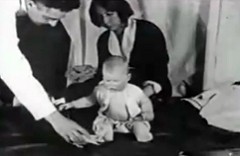
CLASSICAL CONDITIONING

answer
A form of learning in which a previously neutral stimulus, through repeated pairing with a stimulus that ordinarily elicits a response, eventually elicits the response by itself.
question
CLOSED SYSTEM

answer
A self-contained system with impermeable boundaries, operating without interactions outside of the system, resistant to change and thus prone to increasing disorder.
question
COALITIONS

answer
Covert alliances or affiliations, temporarily or long-term, tween certain family members against others in the family.
question
COGNITIVE MODEL
answer
Pertaining to mental processes, such as thinking, remembering, perceiving, expecting, and planning.
question
COGNITIVE BEHAVIORAL THERAPY
answer
A set of therapeutic procedures, derived from behavior therapy, that attempts to change behavior by modifying or altering faulty thought patterns or destructive self-verbalizations.
question
COGNITIVE RESTRUCTURING
answer
An intervention procedure whereby the therapist attempts to modify client thoughts, perceptions, and attributions about an event.
question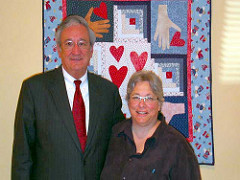
COMPLEMENTARITY

answer
The degree of harmony in the meshing of family roles, as between husband and wife; to the extent that roles dovetail satisfactorily, the partners both are able, together, to provide and receive satisfaction from the relationship.
question
COMPLEMENTARY

answer
A type of didactic transaction or communication pattern in which the inequality and the maximization of differences exists ( for example, dominant/submissive) and in which each participant's response provokes or enhances a counter response in the other in a continuing loop.
question
CONDUCTOR

answer
A type of family therapist who is active, aggressive, and charismatic, openly and directly confronting the families dysfunctional interactive patterns.
question
CONFIDENTIALITY

answer
And ethical standard aimed at protecting client privacy by ensuring that information received in a therapeutic relationship will not be disclosed without prior client consent.
question
CONJOINT
answer
Involving two or more family members seen together in a therapy session.
question
CONJOINT SEX THERAPY
answer
Therapeutic intervention with a couple in an effort to treat their sexual dysfunction.
question
CONSTRUCTIVISM

answer
The belief that an individual's knowledge of reality results from his or her subjective perceiving and subsequent constructing or inventing of the world, rather than resulting from how the world objectively exists.
question
CONTEXTUAL
answer
Pertaining to circumstances or situations in which an event took place; as a therapeutic approach, and emphasis on the relational determinants, entitlements, and indebtedness across generations that bind families together.
question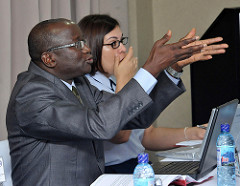
CONTINGENCY CONTRACT

answer
An agreement, usually in written form, made by two or more family members specifying the circumstances under which each is to do something for the other, so that they may exchange rewarding behavior.
question
CONTINUING EDUCATION

answer
voluntary That or, increasingly, mandated postgraduate training, typically in the form of workshops and in-service training programs.
question
CO-THERAPY
answer
The simultaneous involvement of two therapists, often for training purposes, in working with an individual, couple, or family.
question
COUNTER-PARADOX
answer
In systemic family therapy, placing the family in a therapeutic double bind in order to counter the members' paradoxical interactions.
question
COUNTERTRANSFERENCE
answer
According to psychoanalytic theory, the analyst's unconscious emotional responses to a patient that are reminiscent of feelings he or she experienced with a person in the past.
question
CULTURE

answer
Shared behaviors, meanings, symbols, and values transmitted from one generation to the next.
question
CYBERNETICS

answer
The study of methods of feedback control within a system, especially the flow of information through feedback loops.
question
DECONSTRUCTION

answer
A postmodern procedure for gaining meaning by reexamining assumptions previously taken for granted, in the service of constructing new and unencumbered meanings.
question
DEFENSE MECHANISM
answer
According to psychoanalytic theory, the process, usually unconscious, whereby the ego protects the individual from conscious awareness of threatening and therefore anxiety-producing thoughts, feelings, and impulses.
question
DETRIANGULATE
answer
The process of withdrawing from a family role of buffer or go-between with one's parents, so as to not be drawn into alliances with one against the other.
question
DEVELOPMENTAL TASK
answer
Problems to be overcome and conflicts to be mastered at various stages of the life cycle, enabling movement to the next developmental stage.
question
DIFFERENTIATION OF SELF

answer
SELF According to Bowen, the separation of one's intellectual and emotional functioning; the greater the distinction, the better one is able to resist being overwhelmed by the emotional reactivity of his or her family, thus making one less prone to dysfunction.
question
DISENGAGEMENT
answer
A family organization with overly rigid boundaries, in which members are isolated and feel unconnected to each other, with each functioning separately and autonomously and without involvement in the day-to-day transactions within the family.
question
DOUBLE-BLIND

answer
The view that an individual who receives important contradictory injunctions at different levels of abstraction—about which he or she is unable to comment or escape—is in a no-win, conflict-producing situation.
question
DRIVE THERAPY

answer
The psychoanalytic theory that instinctual forces such as sex or aggression create tension states that motivate the individual to take action to lessen the tension.
question
DYAD

answer
A liaison, temporary or permanent, between two persons.
question
ECOMAP
answer
An appraisal tool designed to graphically depict a family's connections with outside agencies and institutions, enabling the therapist to examine pictorially those relationship bonds that connect the family to these systems.
question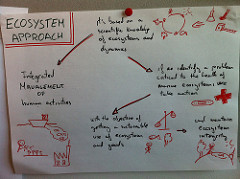
ECOSYSTEMIC APPROACH

answer
A perspective that goes beyond intrafamilial relationships to attend to the family's relationships with larger systems (schools, courts, healthcare).
question
EGO

answer
According to psychoanalytic theory, the mediator between the demands of the instinctual drives (id) and the social prohibitions (superego); thus, the rational, problem-solving aspect of personality.
question
EMOTIONAL CUTOFF

answer
The flight from unresolved emotional ties to one's family of origin, typically manifested by withdrawing or running away from the parental family, or denying its current importance in one's life.
question
EMOTIONALLY FOCUSED COUPLES THERAPY (EFCT)

answer
An experiential approach, based on humanistic, systemic foundations and attachment theory, that attempts to change a couple's negative interactions while helping them to cement their emotional bond.
question
ENACTMENT

answer
In structural family therapy, a facilitating intervention in which the family is induced by the therapist to enact or play out its relationship patterns spontaneously during a therapeutic session, allowing the therapist to observe and ultimately to develop a plan or new set of rules for restructuring future transactions.
question
ENCOUNTER GROUP

answer
A kind of therapeutic group in which intense interpersonal experiences are promoted in order to produce insight, personal growth, and sensitivity to the feelings and experiences of others.
question
ENMESHMENT
answer
A family organization in which boundaries between members are blurred and members are overconcerned and overinvolved in each other's lives, limiting individual autonomy.
question
ENTROPY
answer
The tendency of a system to go into disorder, and if unimpeded, to reach a disorganized and undifferentiated state.
question
EPISTEMOLOGY
answer
The study of the origin, nature, and methods, as well as the limits, of knowledge; thus, a framework for describing and conceptualizing what is being observed and experienced.
question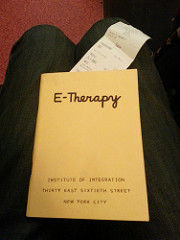
E-THERAPY

answer
Therapy that involves the use of the Internet.
question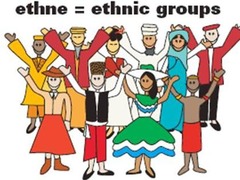
ETHNICITY

answer
The defining characteristics of a social grouping sharing cultural traditions, transmitted over generations and reinforced by the expectations of the subgroup in which the individual or family maintains membership.
question
EXCEPTIONS
answer
In solution-focused therapy, attention to the times when the problem did not occur, intended to help build problem-solving skills.
question
EXPERIENTIAL MODEL
answer
An approach to family therapy that accounts for the unique conflicts and behavior patterns of each family from a psychodynamically informed or Gestalt perspective.
question
EXPRESSED EMOTION

answer
The degree of affect expressed within a family, especially noteworthy in families with schizophrenic members, where emotionally intense and negative interactions are considered a factor in the schizophrenic's relapse.
question
EXTERNALIZATION
answer
In the narrative approach, helping families view the problem or symptom as occurring outside of themselves, in an effort to mobilize them to fight to overcome it.
question
FAMILY CRISIS THERAPY
answer
A crisis-oriented therapeutic approach in which the family as a system is helped to restore its previous level of functioning; in some cases, as with schizophrenia, rehospitalization can be avoided.
question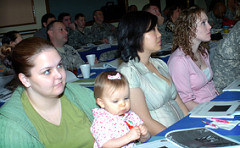
FAMILY GROUP THERAPY

answer
The intervention technique developed by Bell based on social-psychological principles of small-group behavior.
question
FAMILY LEDGER
answer
A concept and therapeutic technique from transgenerational models of therapy that denotes a multigenerational accounting system of what has been given and who, psychologically speaking, still owes what to whom.
question
FAMILY LIFE CYCLE
answer
The series of longitudinal stages or events that mark a family's life, offering an organizing schema for viewing the family as a system proceeding through time.
question
FAMILY LIFE BACK CHRONOLOGY
answer
An experiential technique of Satir's in which clients retrace their family history, particularly the family's relationship patterns, to better understand current family functioning.
question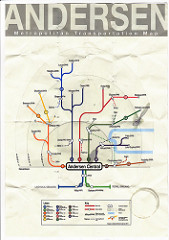
FAMILY MAPPING

answer
An assessment technique used by structural family therapists to graphically describe a family's overall organizational structure and determine which subsystem is involved in dysfunctional transactions.
question
FAMILY PROJECTION PROCESS
answer
The mechanism by which parental conflicts and immaturities are transmitted, through the process of projection, to one or more of the children.
question
FAMILY RECONSTRUCTION
answer
An auxiliary therapeutic approach developed by Satir, whereby family members are guided back through stages of their lives in order to discover and unlock dysfunctional patterns from the past.
question
FAMILY SCULPTING
answer
A physical arrangement of the members of a family in space, with the placement of each person determined by an individual family member acting as "director"; the resulting tableau represents that per¬son's symbolic view of family relationships.
question
FAMILY SYSTEMS THEORY
answer
The theory advanced by Bowen that emphasizes the family as an emotional unit or network of interlocking relationships best understood from a historical or transgenerational perspective.
question
FEEDBACK
answer
The reinsertion into a system of the results of its past performance, as a method of controlling the system.
question
FEEDBACK LOOPS
answer
Those circular mechanisms by which information about a system's output is continuously reintroduced back into the system, initiating a chain of subsequent events.
question
FEMINIST FAMILY THERAPY
answer
A form of collaborative, egalitarian, nonsexist intervention, applicable to both men and women, addressing family gender roles, patrarchal attitudes, and social and economic inequalities in male-female relationships.
question
FIRST-ORDER CHANGE
answer
Temporary or superficial changes within a system that do not alter the basic organization of the system itself.
question
FIRST-ORDER CYBERNETICS
answer
A view from outside the system of the feedback loops and homeostatic mechanisms that transpire within a system.
question
FUNCTIONAL ANALYSIS
answer
A behavioral assessment of a problem in order to determine what interpersonal or environmental contingencies elicit the problematic behavior and how to extinguish or reduce its occurrence.
question
FUNCTIONAL FAMILY THERAPY
answer
A therapeutic approach based on systems theory, cognitive theory, and behavioral principles in which clients are helped to understand the function or interpersonal payoff of certain of their behaviors as a prelude to substituting more effective ways to achieve the same results.
question
FUSION

answer
The merging of the intellectual and emotional aspects of a family member, paralleling the degree to which that person is caught up in, and loses a separate sense of self in, family relationships.
question
GENDER
answer
A learned set of culturally prescribed attitudes and behaviors presumed to be masculine or feminine, associated with but distinct from the biological status of being male or female.
question
GENDER-SENSITIVE FAMILY THERAPY
answer
A therapeutic perspective, regardless of theoretical persuasion, that examines the impact of gender socialization on the out-looks, attitudes, behaviors, and interpersonal relation-ships of men and women; its aim is to empower clients to make sexist-free role choices rather than be limited by roles determined by their biological status as male or female.
question
GENERAL SYSTEMS THEORY

answer
As proposed by biologist Ludwig von Bertalanffy in regard to living systems, the study of the relationship of interactional parts in context, emphasizing their unity and organizational hierarchy.
question
GENOGRAM

answer
A schematic diagram of a families relationship system, in the form of a generic tree and usually including at least three generations; used in particular by Bowen and his followers to trace reoccurring behavior patterns within the family.
question
GESTALT FAMILY THERAPY

answer
A form of experiential family therapy, loosely based on the principles of Gestalt psychology, that focuses on here-and-now experiences in an effort to heighten the self-awareness and increase self-direction.
question
HOLDING ENVIRONMENT
answer
A psychoanalytic concept referring to a therapeutic space analogous to mother-infant environment that allows the patient to safely explore feelings and thoughts often with a sense of play.
question
HOMEOSTASIS
answer
A dynamic state of balance or equilibrium in a system, or a tendency toward achieving and maintaining such a state in an effort to ensure a stable environment.
question
HUMAN VALIDATION PROCESS MODEL
answer
A model of family therapy that emphasizes the collaborative efforts of therapist and family members to achieve family "wellness" by releasing the potential viewed as inherent in every family.
question
HUMANISTIC
answer
The life-affirming view that emphasizes each person's uniqueness and work, as well as potential for continued personal growth and fulfillment.
question
HYPOTHESIZING
answer
As used by systemic therapists, the process by which a team of therapists forms suppositions, open to revision, regarding how and why families problems have developed and persists; to facilitate asking relevant questions and organizing incoming information, it occurs before meeting the family.
question
IDENTIFIED PATIENT (IP)
answer
The family member with the presenting syndrome; thus, the person who initially seeks treatment or for whom treatment is sought.
question
INFORMATION PROCESSING

answer
The gathering, distilling, organizing, storing, and retrieving of information through a system or between that system and larger systems.
question
INFORMED CONSENT
answer
The legal rights of patients or research subjects to be told of the purposes and risks involved before agreeing to participate.
question
INTEGRATIVE COUPLES THERAPY
answer
A behaviorally based technique emphasizing the emotional acceptance of behavior in a partner who is not open to change.
question
INTERPERSONAL

answer
Interactional, as between persons.
question
INTERPRETATION

answer
In psychoanalysis, a primary tool for solving physical symptoms by which unconscious conflicts are made conscious via verbal expression. To be effective, the analyst must time the interpretation to the point when the client can receive and process it.
question
INTERSUBJECTIVE FIELD
answer
The interactive space that involves both the therapist and the client in which both parties are implicated in unconscious or psychodynamic intimacy, exploration, and change.
question
INTRAPSYCHIC
answer
Within the mind or psyche; used especially in regard to conflicting forces.
question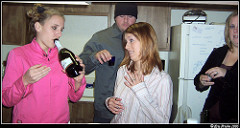
INTERJECTS

answer
Imprints or memories from the past, usually based on unresolved relationships with one's parents, they continue to impose themselves on current relationships, particularly with one's spouse or children.
question
INVISIBLE LOYALTY
answer
In contextual family therapy, a child's unconscious commitment to help the parents, as in becoming the family scapegoat.
question
JOINING
answer
The therapeutic tactic of entering a families system by engaging its separate members and subsystems, gaining access in order to explore and ultimately to help modify dysfunctional aspects of that system.
question
JOINT LEGAL CUSTODY
answer
A term used in the law to denote the rights of divorced parents to share in certain major decisions (e.g. religious upbringing or choice of schools) regarding their children.
question
LICENSING
answer
A statutory process established by a government agency, usually a state province, granting permission to persons having met predetermined qualifications to practice a specific profession.
question
LINEAR CAUSALITY

answer
The view that a non-reciprocal relationship exists between events in the sequence, so that one event causes the next event, but not vice versa.
question
MALPRACTICE
answer
A legal concept addressing the failure to provide a level of professional skill or render a level of professional services ordinarily expected of professionals in a similar situation.
question
MANAGED CARE
answer
A system in which third-party payouts regulate and control the cost, quality, and terms of treatment of medical (including mental health) services.
question
MARITAL QUID PRO QUO
answer
An initial rule arrangement or bargain between husband-and-wife regarding the ways in which they intend to define themselves vis-a-vis another in marital relationship.
question
MARITAL SCHISM
answer
A disturbed marital situation characterized by family disharmony, self preoccupation, the undermining of the spouse, and frequent threats of divorce by one or both partners.
question
MARITAL SKEW
answer
A disturbed marital situation in which one partner dominates the family to an extreme degree, and in which the marriage is maintained at the expense of the distortion of reality.
question
MEDICAL FAMILY THERAPY
answer
A form of psychoeducational family therapy involving collaboration with physicians and other healthcare professionals in the treatment of persons or families with health problems.
question
META-ANALYSIS
answer
A statistical technique for reviewing, analyzing, and summarizing the results of a discrete group of studies, as in investigating the differences between treatment and no-treatment groups in outcome research.
question
META-COMMUNICATION
answer
A message about a message, typically nonverbal ( a smile, a shrug, a nod, wink), offered simultaneously with a verbal message, structuring, qualifying, or adding meaning to that message.
question
META-RULES
answer
A families unstated rules regarding how to interpret or, if necessary, to change its rules.
question
MILAN SYSTEMIC MODEL
answer
An approach to family therapy with origins in the strategic tradition that adapted postmodern/second-order cybernetics perspectives designed to help families examine their own thoughts, attitudes, beliefs, and meanings they attach to their own behaviors.
question
MIMESIS

answer
A tactic used particularly by structural family therapists, who attempt to copy or mimic families communication and behavioral patterns in order to gain acceptance by the family members.
question
MIRRORING
answer
A psychoanalytic technique in which aspects of the clients in her life are reflected back in a non-judgmental way to strengthen a sense of self and encourage self-esteem. Mirroring is not empathy, as the former is used to normalize behavior rather than simply understanding it.
question
MONAD

answer
Properties or characteristics of a single individual.
question
MULTIGENERATIONAL TRANSMISSION PROCESS
answer
The process, occurring over several generations, in which poorly differentiated persons Mary similarly differentiated mates, ultimately resulting in offspring suffering from schizophrenia or other severe mental disorders.
question
MULTIPLE FAMILY THERAPY
answer
A form of therapy in which members of several families meet together as a group to work on individual as well as family problems.
question
MULTIPLE IMPACT THERAPY
answer
A crisis-focused form of intervention in which members of a single family are seen altogether, or in various combinations, for intensive interaction with a team of professionals over a two-day period.
question
NARCISSISTIC PERSONALITY DISORDER
answer
a pattern of outlandish self-investment and exhibitionistic recognition seeking in which the individual attempts to evoke attention and admiration from others, but is himself or herself unable or unwilling to empathize with their needs or desires.
question
NARRATIVE THERAPY
answer
A postmodern therapeutic approach in which the therapist and family members construct new stories about their lives that encourage the possibility of new experiences.
question
NEGATIVE FEEDBACK
answer
The flow of corrective information from the output of a system back into the system in order to attenuate deviation and keep the system functioning within prescribed limits.
question
NEGENTROPY
answer
The tendency of the system to remain flexible and open to new input, necessary for change and survival of the system.
question
NETWORK THERAPY
answer
a That form of therapy, typically carried out in the home of the patient ( for example, a schizophrenic recently discharged from the hospital), in which family members, friends, neighbors, and other involved persons participate in treatment and rehabilitation.
question
NEUTRALITY

answer
As used by systemic family therapist, a nonjudgmental and impartial position, eliciting all viewpoints, intending to enable the therapist to avoid being caught up in family "games" to coalitions or alliances.
question
NUCLEAR FAMILY
answer
A family composed of a husband, wife, and their offspring, living together as a family unit.
question
OBJECT RELATIONS THEORY

answer
The theory that the basic human motive is the search for satisfying object ( human) relationships, and that parent-child patterns, especially if frustrating or fulfilling, art internalized as interjects and unconsciously impose on current family relationships.
question
ONE-PERSON PSYCHOLOGY
answer
A phrase referring to the classical psychoanalytic understanding of the analyst and patient being distinctly separate people with the analyst in possession of objective knowledge about the patient that is in part it to her or him the interpretation and other interventions. (See two-person psychology.)
question
OPEN SYSTEM
answer
A system with more or less permeable boundaries that permits interaction between the system's component parts or subsystems and outside influences.
question
POSITIVE FEEDBACK
answer
The flow of information from the output of a system back into the system in order to amplify a deviation from the state of equilibrium, thus leading to instability and change.
question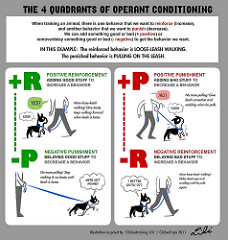
OPERANT CONDITIONING

answer
A form of learning in which corrector desired responses are rewarded or reinforced, thus increasing the probability that these responses will recur.
question
POSTMODERNISM

answer
A philosophical outlook rejecting the notion that there exists an objectively knowable universe discoverable by impartial science, and instead arguing that there are multiple views of reality ungoverned by universal laws.
question
OPERANT INTERPERSONAL THERAPY
answer
A marital therapy approach based on operant conditioning theory, particularly the exchange between partners of positive rewards.
question
POWER
answer
Influence, authority, and control over an outcome.
question
ORGANIZATION

answer
The notion that the components of a system relate to each other in some consistent fashion, and that the system is structured by those relationships.
question
PRESCRIBING THE SYMPTOM
answer
A paradoxical technique in which the client is directed to voluntarily engage in the asymptomatic behavior; as a result, the client is put in the position of rebuilding and abandoning the symptom or obeying, thereby admitting it is under voluntary control.
question
ORGANIZING PRINCIPLES
answer
In intersubjective psychoanalysis, the mutually informing unconscious patterns established by client and analyst that structure their experiences together.
question
PPROBLEM ANALYSIS
answer
An investigation of a presenting problem, typically carried out by behaviorists, in order to determine as precisely as possible what behavioral deficiencies require targeting.
question
PARADIGM
answer
A set of assumptions delimiting an area to be investigated scientifically and specifying the methods he used to collect and interpret the forthcoming data.
question
PROJECTIVE IDENTIFICATION
answer
An unconscious defense mechanism whereby certain unwanted aspects of oneself are attributed to another person (e.g., a spouse), who is then induced or incited to behave according to the first person's projected but split-off feelings.
question
PSEUDO-HOSTILITY
answer
A process by which families employed Pickering and turmoil to maintain their relationship, avoiding tenderness and covering up deeper feelings, often of greater underlying hostility.
question
PARADOXICAL INJUNCTION
answer
A communication to obey a command that is internally inconsistent and contradictory, as in double-blind message, forcing the receiver to disobey an order to obey.
question
PARADOXICAL INTERVENTION
answer
A therapeutic technique whereby a therapist gives a client or family eight directive he or she wants resisted; as a result of defying the directive, the change takes place.
question
PSEUDO-MUTUALITY
answer
A homeostasis-seeking relationship between and among family members that gives the surface appearance of being open, mutually understanding, and satisfying, when in fact it is not.
question
PEER REVIEW

answer
A process of assessing and other therapists professional procedures or intended procedures; under managed care contracts, such a valuations in a case-by-case procedure are performed by a case management coordinator representing a third-party payor.
question
PERMEABILITY
answer
The ease her flexibility with which members can cross subsystem boundaries within the family.
question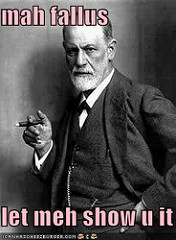
PSYCHOANALYSIS

answer
A comprehensive theory of personality development and set of therapeutic techniques developed by Sigmund Freud in the early 1900s.
question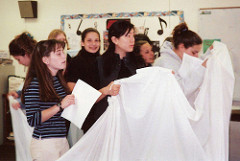
PSYCHODRAMA

answer
A form of group therapy in which some participants role-play themselves or significant others in their lives to achieve catharsis or to resolve conflicts and gain greater spontaneity.
question
PSYCHODYNAMICS
answer
The interplay of opposing forces within an individual as the basis for understanding that person's motivation.
question
PSYCHOPATHOLOGY
answer
A disease concept derived from medicine, referring to the origins of abnormal behavior.
question
PUNCTUATION

answer
The communication concept that each participant in a transaction believes whatever he or she is says is caused by what the other says, in effect holding the other responsible for his or her reactions.
question
PHENOMENOLOGICAL
answer
The view that to fully understand the causes of another's person's behavior requires an understanding not of the physical or objective reality of the person's world, but of how he or she subjectively experiences that world.
question
POSITIVE CONNOTATION
answer
A reframing technique used primarily by systematic family therapist whereby positive motives are ascribed to family behavior patterns because those patterns help maintain family balance and cohesion; as result, the family is helped to view each other's motives more positively.
question
RADICAL BEHAVIORISM
answer
The Outlook offered by B.F. Skinner that overt or observable behavior is the only acceptable subject of scientific investigation.
question
SCHIZOPHRENIA

answer
A group of severe mental disorders characterized by withdrawal from reality, blunted or in¬appropriate emotion, delusions, hallucinations, incoherent thought and speech, and an overall breakdown in personal and social functioning.
question
REACTOR
answer
Therapist whose style is subtle and indirect, and who prefers to observe and clarify the family process rather than serve as an active, aggressive, or colorful group leader.
question
REDUNDANCY PRINCIPAL
answer
Repetitive behavioral sequences within a family.
question
REFLECTING TEAMS
answer
A process involving two-way mirrors in which team members observe a family and then discuss their thoughts and observation in front of the family and therapist. Later, the therapist and family discussed the teams conversations about them.
question
REFRAMING
answer
relabeling behavior by putting it into a new, more positive perspective ( "mother is trying to help" rather than "she's intrusive"), thus altering the context in which it is perceived and inviting new responses to the same behavior.
question
REINFORCEMENT
answer
A That response, in the form of a were Ward or punishment, intended to change the probability of the occurrence of a previous response.
question
SCHIZOFROGENIC MOTHER
answer
According to Fromm-Reichman, a cold, domineering, possessive but rejecting mother (usually married to an inadequate, passive husband) was behavior towards her son is thought to be a determining factor in his schizophrenic behavior.
question
SECOND-ORDER CHANGES
answer
Fundamental changes in a systems organization, function, and frame of reference, leading to permanent change in its interactive patterns.
question
SECOND-ORDER CYBERNETICS
answer
A view of an observing system in which the therapist, rather than attempting to describe the system by being an outside observer, is part of what is being observed and treated.
question
SELFOBJECTS
answer
According to Kohut, unconscious images or representations of another person or object viewed by infants as extension of themselves while they are in the process of gaining self-esteem.
question
RELABELING
answer
Verbal redefinition of an event in order to make dysfunctional behavior seem more reasonable and understandable, intended to provoke in others a more positive reaction to their behavior.
question
SELF PSYCHOLOGY
answer
An object-relations-based theory, advanced by Kohut, that emphasizes the role of narcissism informing an authentic and coherent sense of self.
question
SHAPING

answer
A form of behavioral therapy, based on operant conditioning principles, in which successive approximations of desired behavior are reinforced until the desired behavior is achieved.
question
SIBLING POSITION
answer
The birth order of children in a family, which influences their personalities as well as their interactions with future spouses.
question
SOCIAL LABELING THEORY
answer
The theory that a person's behavior is best understood when the conditions under which the behavior is learned are taken into account.
question
SOCIETAL REGRESSION
answer
Bowen's notion that society responds emotionally in periods of stress and anxiety, offering short term "Band-Aid" solutions, rather than seeking more rational solutions that lead to greater individuation.
question
SPLITTING
answer
According to object relations theory, a primitive process by which an infant makes contradictory aspects of a mother or other nurturing figure less threatening by dividing the external person into a good object and a bad object and internalizing the split perception.
question
RELATIONAL ETHICS
answer
In Contextual Family Therapy, the overall, long-term preservation of fairness within a family, ensuring that each family member's basic interests are taken into account by the other family members.
question
RESILIENCE

answer
The ability to maintain stability and rebound in response to loss or trauma.
question
RESISTANCE
answer
A psychoanalytic concept that accounts for the unconscious opposition to therapeutic change.
question
RITUALS
answer
Symbolic ceremonial prescriptions offered by a therapist, intended to address family conflict over its covert rules, to be enacted by the family in order to provide clarity or insight into their roles and relationships.
question
RUBBER FENCE
answer
As proposed by Wynne, shifting boundary around a family, intended to protect them from outside contact, arbitrarily permitting certain acceptable bits of information to penetrate, but not others.
question
SCHEMAS
answer
Relatively stable cognitive structures involving underlying core beliefs a person develops about the world.
question
SCHIZOID
answer
The inability to form social relationships or to concern oneself with the desires, needs, or feelings of others.
question
STEPFAMILY
answer
A linked family system created by the marriage of two persons, one or both of whom have been previously married, in which one or more children from the earlier marriage(s) live with the remarried couple.
question
STRATEGIC APPROACH
answer
A therapeutic approach in which the therapist develops a specific plan or strategy and design interventions aimed at solving the presenting problem.
question
STRUCTURAL MODEL
answer
A therapeutic approach directed at changing or realigning the family organization or structure in order to alter dysfunctional transactions and clarify subsystem boundaries.
question
SUBSYSTEM

answer
An organized, coexisting component within an overall system, having its own autonomous functions as well as specified role in the operation of the larger system; within families, a member can belong to a number of such units.
question
SUPRASYSTEM
answer
A higher level system in which other systems represent component parts and play subsystem roles.
question
SYMBIOSIS

answer
An intense attachment between two or more individuals, such as a mother and a child, to the extent that the boundaries between them become blurred, and they respond as one.
question
SYSTEMS THEORY
answer
A generic term in common use, encompassing general systems theory and cybernetics, referring to the view of interacting units are elements making up organized whole.
question
THERAPEUTIC DOUBLE-BLIND
answer
A general term that describes a variety of paradoxical techniques used to change entrenched family patterns.
question
THERAPEUTIC CONTRACTS
answer
As used by Behavioral Family Therapists written negotiated agreements between family members to make specific behavior changes in the future.
question
TIME OUT
answer
A behavioral technique for extinguishing undesirable or inappropriate behavior by removing the reinforcing consequences of that behavior; the procedure is used primarily with children
question
TOKEN ECONOMY
answer
A program in which tokens ( points, gold stars) are dispensed contingent upon the successful completion of previously designated desired behaviors; accumulated tokens can be redeemed later for money, or special privileges.
question
TRACKING
answer
A therapeutic tactic associated with Structural Family Therapy, in which the therapist deliberately attends to the symbols, style, language, and values of the family, using them to influence the family's transactional patterns.
question
TRANSFERENCE
answer
In psychoanalytic treatment, the unconscious shifting onto the analyst of a patient's feelings, drives, attitudes, fantasies, displaced from unresolved reactions to significant persons in the patient's past.
question
SYMBOLIC EXPERIENTIAL FAMILY THERAPY (5-EFT) MODEL
answer
A multigenerational approach that uses therapy to address both individual and family relational patterns. The therapist assumes a pivotal role in helping family members dislodge rigid and repetitive ways of interacting by substituting more spontaneous and flexible ways of accepting and dealing with their impulses..
question
SYMMETRICAL ESCALATION
answer
A spiraling competitive effect in the communication between two people whose relationship is based on equality, so that vindictiveness leads to greater vindictiveness and return, viciousness to greater viciousness, and so forth.
question
SYSTEM

answer
A set of interacting units or component parts that together make up a whole arrangement or organization.
question
SYMMETRIC FAMILY THERAPY
answer
A Milan-model therapeutic approach in which the family, as an enveloping system, is viewed as continuing to use an old epistemology that no longer fits in its current behavior patterns; the therapist indirectly introduces new information into the family system and encourages alternative epistemologies to develop.
question
TRANSGENERATIONAL MODEL
answer
In family therapy, accents how current family patterns, alliances, and boundaries are embedded in unresolved issues from the family's origin.
question
TRIAD
answer
A three-person set of relationships.
question
TRIANGLE

answer
A three-person system, the smallest stable emotional system; according to Boeing, a two-person emotional system, under stress, will recruit a third person into the system to lower the intensity anxiety and gain stability.
question
TRIANGULATION

answer
A process in which each parent demands that a child ally with him or her against the other parent during parental conflict.
question
TWO-PERSON PSYCHOLOGY
answer
A term from more contemporary forms of psychoanalysis and psychodynamic psychotherapy that recognizes that mutuality (unconscious and conscious) in the therapeutic dyad that leads to co-constructed therapeutic gains. (see one-person psychology)
question
UNIQUE OUTCOMES
answer
In narrative therapy, those instances when the client did not experience the problem; such outcomes are intended to help contradict clients problem-saturated outlook.
question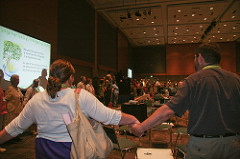
WHOLENESS

answer
The systems view that combining units, components, or elements produces an entity greater than the sum of its parts.
question
UNBALANCING
answer
In structural family therapy, a technique for altering the hierarchal relationship between members of a system or subsystem by supporting one member and thus upsetting family homeostasis.
question
UNDIFFERENTIATED FAMILY EGO MASS
answer
Bowen's term for an intense, symbiotic nuclear family relationship; an individual sense of self fails to develop in members because of existing fusion or emotional "stuck-togetherness".



